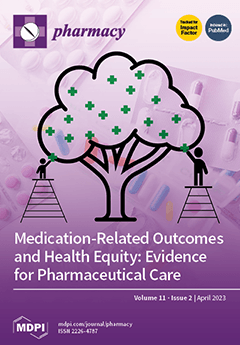The CDC’s Core Elements of an Antimicrobial Stewardship Program (ASP) lists intravenous (IV) to oral (PO) conversion as an important pharmacy-based intervention. However, despite the existence of a pharmacist-driven IV to PO conversion protocol, conversion rates within our healthcare system remained low. We
[...] Read more.
The CDC’s Core Elements of an Antimicrobial Stewardship Program (ASP) lists intravenous (IV) to oral (PO) conversion as an important pharmacy-based intervention. However, despite the existence of a pharmacist-driven IV to PO conversion protocol, conversion rates within our healthcare system remained low. We aimed to evaluate the impact of a revision to the current conversion protocol on conversion rates, using linezolid as a marker due to its high PO bioavailability and high IV cost. This retrospective, observational study was conducted within a healthcare system composed of five adult acute care facilities. The conversion eligibility criteria were evaluated and revised on 30 November 2021. The pre-intervention period started February 2021 and ended November 2021. The post-intervention period was December 2021 to March 2022. The primary objective of this study was to establish if there was a difference in PO linezolid utilization reported as days of therapy per 1000 days present (DOT/1000 DP) between the pre- and post-intervention periods. IV linezolid utilization and cost savings were investigated as secondary objectives. The average DOT/1000 DP for IV linezolid decreased from 52.1 to 35.4 in the pre- and post-intervention periods, respectively (
p < 0.01). Inversely, the average DOT/1000 DP for PO linezolid increased from 38.9 in the pre-intervention to 58.8 for the post-intervention period,
p < 0.01. This mirrored an increase in the average percentage of PO use from 42.9 to 62.4% for the pre- and post-intervention periods, respectively (
p < 0.01). A system-wide cost savings analysis showed projected total annual cost savings of USD 85,096.09 for the system, with monthly post-intervention savings of USD 7091.34. The pre-intervention average monthly spend on IV linezolid at the academic flagship hospital was USD 17,008.10, which decreased to USD 11,623.57 post-intervention; a 32% reduction. PO linezolid spend pre-intervention was USD 664.97 and increased to USD 965.20 post-intervention. The average monthly spend on IV linezolid for the four non-academic hospitals was USD 946.36 pre-intervention, which decreased to USD 348.99 post-intervention; a 63.1% reduction (
p < 0.01). Simultaneously, the average monthly spend for PO linezolid was USD 45.66 pre-intervention and increased to USD 71.19 post-intervention (
p = 0.03) This study shows the significant impact that an ASP intervention had on IV to PO conversion rates and subsequent spend. By revising criteria for IV to PO conversion, tracking and reporting results, and educating pharmacists, this led to significantly more PO linezolid use and reduced the overall cost in a large healthcare system.
Full article





